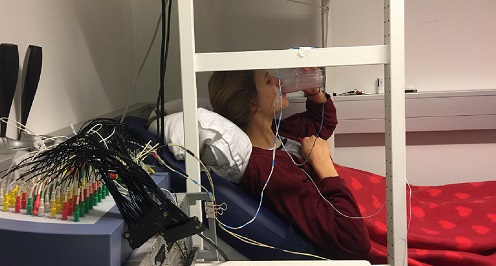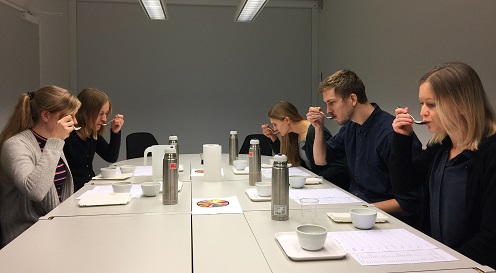New ‘Future Consumer Lab’ will research food with consumers as a starting point
In January, a new ‘Future Consumer Lab’ (FCL) opens at the University of Copenhagen in Denmark. The new lab puts the consumers at the centre of the development of food. FCL has 7 different laboratories, including a simulation laboratory where researchers use Virtual Reality to test different foods and meals. The researchers in FCL can help the food industry to develop innovative products and society to fight, e.g., malnutrition and obesity.

Test in the Physiology Lab. Picture: Lene Hundborg Koss
Will we eat more vegetables or more fish if they are included in meals with more complex or better-designed appetitising flavours? Which flavour components, visual factors and textures can you change to avoid overeating? Through the new ‘Future Consumer Lab’ at the University of Copenhagen, researchers can delve into what happens to our eating behaviour when you change different parameters of our food or the environment that surrounds us when we eat.
“Approximately 25 researchers are affiliated with the laboratory, which has a number of newly remodelled locations and new equipment. This means that we are better able to put people and consumers at the centre in relation to food”, says Professor Wender Bredie, who heads Design and Consumer Behavior at the Department of Food Science.
The research can help the food industry to create more innovative products and create better conditions for controlling lifestyle diseases.
“What is unique is that the ‘Future Consumer Lab’ links consumer science with nutritional science, flavour science and exploratory gastronomy, all of which are disciplines wherein the Department of Food Science already has talented researchers with strong competencies. In addition, we collaborate with other institutes at the University of Copenhagen – especially the Department of Nutrition, Exercise and Sports”, says Wender Bredie.
The missing angle

“For example, we bring many meals out to older citizens who cannot cook for themselves, but our research shows that about fifty percent of these consumers throw out up to twenty percent of the meals. The older citizens do not want to eat it – even though it meets all of the requirements for proper nutrition. One reason for this is that we have not had enough focus on also creating good flavours, or thought about the context surrounding the food and what the weakest individuals can and will eat”, he says.
According to Wender Bredie, consumer science has been left behind, which has had consequences, for example, in elderly care, but possibly also in developing less desirable eating habits. For, while nutritional science aims to combine food and meals in a sensible manner from a nutritional point of view, there has not been enough focus on what consumers want to eat and how the food composition influences consumption behaviour. With some consumer groups, one wants to stimulate consumption behavior, whereas in others, one wants to find new ways to reduce food intake.
Many of the most vulnerable older people are malnourished or undernourished and are thus at risk for disability and disease.
Virtual Reality sends testers on eating trips
The Future Consumer Lab uses Virtual Reality equipment to explore our senses in relation to food.
“In our Simulation Lab we can put testers in different scenarios, such as a food market in China, where you as a food producer will be able to see how your new product performs. We will be able to study how different contexts affect how the test participants interact with different kinds of food”, says Wender Bredie.
At the same time, the Future Consumer Lab is used by students in the Food Innovation and Health master’s programme, where they learn how important consumer behaviour is when developing new products.
“Our Observation Lab is available in two versions – one for researchers and the food industry and one where students can test their hypotheses. The Observation Lab for the students is close to the Gastro Lab, which is equipped as a professional research kitchen. It provides optimal opportunities to work with innovative ingredients and meals, new flavours and local ingredients in new food contexts”, says Wender Bredie.
Future Consumer Lab has 7 laboratories:
Simulation Lab, where one can study different degrees of immersion in virtual realities. The lab can simulate sounds, temperatures and visual surroundings by Virtual Reality goggles. By creating such Virtual Realities, researchers can study how contextual factors affect food preferences, choice of products, the desire to eat or possibly appetite. Using Virtual Reality, one can put people in different contexts using 3D movies of real life or a computer designed copy of different scenarios. For example, you are at an ice-cream stand on Copacabana beach, feel the heat, hear and see the people moving around you while having to make a choice of ice cream.
Flavour Lab, where researchers can characterise key flavour components in foods. This is done by sampling volatile and non-volatile compounds, separating and identifying them to assess which compounds contribute to positive food flavours or off-flavours. Flavour Lab is connected to the Sensory Lab, with the taste and smell sensory panel, and results can be used in the Physiology Lab.
Physiology Lab, where one can measure emotional responses to foods by electrode sensors on the body. Also, conditioning to food properties can be studied by measuring brain activity. The equipment can be moved into the Simulation Lab, so one can also measure the responses in a Virtual Reality-created scenario. Furthermore, the Physiology Lab houses an olfactometer that can deliver precise amounts of odour to subjects. This equipment is suitable for evoking odour signals to measure how well testers are able to perceive different smells and how they behave towards them.

Test panel in the Sensory Lab tasting coffee. Picture: Lene Hundborg Koss
Sensory Lab, which works to measure the quality characteristics of foods and meals that can be detected by the senses. The work is carried out by trained sensory panels, including a taste and smell panel. The Sensory Lab designs experiments and carries out blind tests for use in both research and the food industry. In connection with the renovation, the laboratory has expanded capacity and is now able to perform preference and acceptance measurements with up to 20 consumers at a time. In addition to testing different foods and ingredients using consumer tests, or tests carried out using the taste and smell sensory panel, the laboratory is also working on developing new rapid testing methods.
Observation Lab - Research, which examines how we act in relation to different environments and presentations of food and meals. The laboratory is equipped with cameras that can zoom in on a consumer that chooses food from a buffet or eats a meal from a plate. Buffet studies take place in a room that can be decorated for different eating situations, and the meal can be arranged according to various aesthetic and sensory principles. The studies will provide insight into how consumers select and eat the meal with regard to the visual, textural and taste characteristics, as well as small implicit messages known as “nudging”. The Observation Lab is closely linked to the exploratory gastronomy of the Nordic Food Lab and the Gastro Lab, where the test food is prepared. The laboratory is primarily for researchers and collaborators in the food industry.
Observation Lab – Education is used in the same way as described above, but is preferable for teaching students in the Food Innovation and Health master’s programme.
Gastro Lab is an advanced research kitchen, in which the food to be served in the Observation Lab is prepared.
Topics
Related News
Contact
Professor Wender Bredie, Department of Food Science (FOOD), University of Copenhagen, wb@food.ku.dk
Or
Communications Officer, Department of Food Science (FOOD), University of Copenhagen, Lene Hundborg Koss, lene.h.koss@food.ku.dk
Coffee’s journey through the FCL
Imagine that a company that produces coffee wants to examine the characteristics of coffee in detail in order to develop new products.
In the Flavour Lab, we can figure out which flavour components give the coffee its aroma and taste. You can study the importance of individual components in relation to good flavour, but also in regard to off-flavour notes.
In the Simulation Lab, we can examine how coffee is experienced in different scenarios: at the café, on the beach, in the home environment.
In the Physiology Lab, we can investigate how images of coffee or the coffee itself affect the testers emotionally, and how preferences are learned. Using an olfactometer, we can also test the fragrance experience and, for example, test high-quality coffee against coffee of a poorer quality.
In the Sensory Lab, we can carry out controlled taste tests with a trained sensory panel using different cupping or drinking protocols. The panel can assess the sensory characteristics of the coffee – such as taste, temperature, mouthfeel – and various associative impressions, and the results can be related to those of the Flavour Lab.
In the Observation Lab, you can use testers to examine a number of factors relating to consumer choice and drinking behaviour: what the presentation of the coffee means for consumption; what the time of the day means; what the accompaniment means; the temperature, etc.
